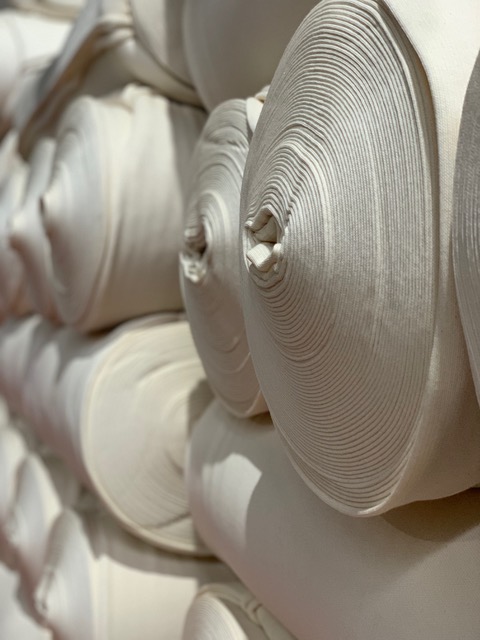According to the European Commission, textile consumption is the 4th largest source of environmental impact in Europe, after food, housing and transport. Employing over 1.5 million Europeans, this sector plays a crucial role in the local economy (Sustainable and Circular Textiles Factsheet – 2022). Faced with the urgency of climate change, the European Commission plans to regulate the fashion industry by 2030 to meet European citizens’ expectations in terms of sustainability.
What is eco-responsible fashion? La mode éco-responsable, c’est quoi ?
Eco-responsible fashion takes into account environmental impact through the choice of materials, production processes and fair working conditions. This concept, also known as “slow fashion”, aims to counter the fast fashion trend and promote sustainable textile consumption. Buying eco-responsible means choosing clothes made from organic materials, produced locally, and in working conditions that respect employees.

What criteria should be considered when assessing a brand’s ecoresponsibility?
Assessing a brand’s ecoresponsibility involves analyzing several key aspects, from raw materials to production practices.
Raw materials and fabric durability: Opt for organic and recycled materials.
Local production and reduction of carbon footprint: Favor local manufacturing.
Quantities produced and the fight against over-consumption: Avoid mass production.
Inks and toxic waste management: Use non-toxic dyes and recycle waste.
Eco-responsible certifications and labels: Examples of certifications include GOTS, OEKO-TEX.
Social and environmental impact of production processes: Ensure fair working conditions.
Buying a brand that claims to be eco-responsible requires a great deal of information. Many brands offer collections in organic cotton, but these are made in Bangladesh, for example, where labor costs are 10 times lower than in France, working conditions are exploitative, and transport is long and polluting. In short, by no means an eco-responsible brand.
Many companies also import organic cotton products from these countries and print them in France, which again is far from being able to be labelled eco-responsible.
At Mangrose, we’re committed to ethical, eco-responsible fashion. Our garments are produced in Portugal, with GOTS certifications guaranteeing the use of organic cotton. By limiting the impact of transport to France, we reduce our carbon footprint. We also donate 5 euros per model sold, to environmental, animal rights and societal causes.
How can changing the way we buy clothes have an impact on the planet
As consumers, choosing sustainable clothes can transform the environmental impact of our clothing habits.
Observation: textile consumption since the 70s
The last 50 years have seen the textile industry transform. As early as 1970, we saw an increase in textile imports, particularly from Asia. Then, in the 90s, fast fashion chains appeared. And finally, in the 2020s, ultra-fast fashion launched its online sales: a disaster of textile over-consumption with an appalling environmental impact.
Price impact without limits
Since the 70s, we’ve become accustomed to ever-lower prices, especially in the big chains. These prices are only possible because the products are manufactured in Asia, mainly in China and Bangladesh, where labor costs are 10 times lower than in France.
This sometimes implies lower quality (but not necessarily), production that does not benefit French industry, different labor regulations, and 8,000 km transport for delivery, which has a major impact on the climate. And it’s not just the major retailers who are responsible, since high-end/luxury brands also have some of their models produced there, which is even more shocking since the selling price remains extremely high for a maximum margin.

How can this be changed? What are the possible solutions?
One possibility is to buy less but better: “more local” in Europe or France. (Better made, better thought out) and less polluting to protect the planet.
“Fashion goes out of fashion, style never does” said Cocco Chanel.
Take the time to define your style, and buy clothes that make sense to you and protect the planet. Everyone can find their own rhythm.
The solution to changing habits is individual and gradual.
It’s time to activate RESET mode.
RESET mode by MANGROSE: Rethinking your textile consumption
Discover RESET mode by MANGROSE, a simple, step-by-step method for transforming your clothing habits. This guide will help you adopt a more ethical and sustainable consumption pattern.
R.E.S.E.T.
RECONSIDER :
Before you buy, take the time to reassess your wardrobe. Take a break, look at what you already have, and rethink what you really need. By reducing the frequency of your purchases, you encourage more sustainable fashion and limit over-consumption.
ENVISION :
Envision a future where ethical and sustainable fashion is the norm. Every purchase counts: your choices influence working conditions, production practices and the ecological footprint of clothing. By buying consciously, you support a consumption model that respects the environment and workers.
STRUCTURE :
Structure / Establish a new way of buying clothes sustainably and thoughtfully. Favor local brands, recycling and upcycling. Take inspiration from the principles of minimalism to structure your wardrobe according to your true needs. Dominique Loreau, author of L’art de la simplicité (The art of simplicity), suggests sorting out essential clothes for a coherent, sustainable wardrobe.
EVALUATE :
Take stock of how far you’ve come. Be proud of the efforts you’ve made to reduce your purchases and prioritize quality. Every choice you make contributes to a more respectful future for future generations and for our planet.
TAKE BENEFIT OF IT :
Make the most of these habit changes. Enjoy all the benefits of your new way of consuming: a simplified wardrobe, quality clothes that last, and the satisfaction of contributing to a more sustainable world.
By adopting the RESET mode, you’re joining a movement towards ethical, eco-friendly fashion. At MANGROSE, we believe that together, we can make a difference. By activating RESET mode, you’re choosing fashion that takes care of the planet and future generations.

